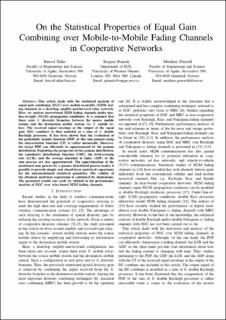On the Statistical Properties of Equal Gain Combining over Mobile-to-Mobile Fading Channels in Cooperative Networks
Journal article, Peer reviewed
Permanent lenke
http://hdl.handle.net/11250/137793Utgivelsesdato
2010Metadata
Vis full innførselOriginalversjon
Talha, B., Primak, S. & Pätzold, M. (2010). On the Statistical Properties of Equal Gain Combining over Mobile-to-Mobile Fading Channels in Cooperative Networks. In IEEE International Conference on Communications. IEEE. http://dx.doi.org/10.1109/ICC.2010.5501898Sammendrag
This article deals with the statistical analysis of equal gain combining (EGC) over mobile-to-mobile (M2M) fading channels in a dual-hop amplify-and-forward relay network. Here, we analyze narrowband M2M fading channels under nonline-of-sight (NLOS) propagation conditions. It is assumed that there exist K diversity branches between the source mobile station and the destination mobile station via K mobile relays. The received signal envelope at the output of the equal gain (EG) combiner is thus modeled as a sum of K double Rayleigh processes. It has been shown that the evaluation of the probability density function (PDF) of this sum process using the characteristic function (CF) is rather intractable. However, the target PDF can efficiently be approximated by the gamma distribution. Exploiting the properties of the gamma distribution, the cumulative distribution function (CDF), the level-crossing rate (LCR), and the average duration of fades (ADF) of the sum process are also approximated. The approximation of the mentioned sum process by a gamma distributed process makes it possible to provide simple and closed-form analytical expressions for the aforementioned statistical quantities. The validity of the obtained analytical expressions is confirmed by simulations. The presented results can easily be utilized in the performance analysis of EGC over relay-based M2M fading channels.
Utgiver
IEEETidsskrift
IEEE International Conference on CommunicationsOpphavsrett
© 2010 IEEEPersonal use of this material is permitted. However, permission to reprint/republish this material for advertising or promotional purposes or for creating new collective works for resale or redistribution to servers or lists, or to reuse any copyrighted component of this work in other works must be obtained from the IEEE.
